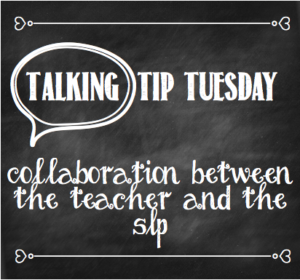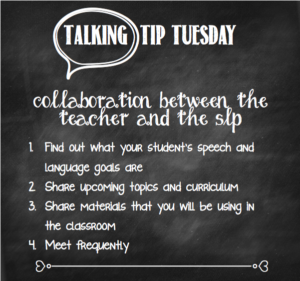Happy half-term break to all my fellow teachers and SLTs in the UK! I hope that you are enjoying a well-deserved week off.
My tip today is dedicated to all of the hard working teachers who work in classrooms with students of all different backgrounds, needs, strengths, and weaknesses. In almost every classroom, you will find at least one student who has speech and language delays or difficulties and therefore you will find yourself interacting and hopefully collaborating with the speech and language pathologist/therapist (hereby referred to as the SLP!)
Why is collaboration important?
Collaboration is not easy. It takes extra time, planning, and effort. On a day to day basis it can definitely seem easier for teachers and SLPs to remain in their own bubbles, and each work with their student independently. BUT (and it's a big but!) it's not best practice, and actually is not efficient or productive. In the long run, working together will save time, and help your student achieve their speech and language goals much faster while also being more successful in the classroom.
By incorporating and integrating classroom curriculum into my sessions with students, I can ensure that the work that I do with them is relevant and help them to make connections and generalise information from speech therapy into the classroom. On the other hand, when teachers incorporate my speech and language goals for students into the student's work in the classroom, students are practicing their speech and language goals more often and are able to achieve them much faster.
Tips for Collaborating with an SLP
Find out what your student's speech and language goals are.
It's important to know where your student's area of difficulties lie and how they can affect their performance in the classroom. The SLP will share with you what your student's goals are and how you can support them in the classroom to help them be most successful. For example, if your student has difficulties understanding complex language the SLP can support you by giving ideas about how to incorporate more visuals into your teaching and also share other strategies for helping the student access information in the classroom.
Share upcoming topics and curriculum
I always like to find out from the teachers of my students what topics will be covered in class in the upcoming weeks and months. It helps to know specifically what types of vocabulary will be used, and what the expectations of the student will be regarding what is being taught. Knowing this information helps me to prepare my sessions. For example, if I know that an upcoming topic in class will be animals and their habitats and one of the student's speech and language goals is to increase their descriptive vocabulary, we can work on describing animals and/or habitats in our sessions.
Share materials that you will be using in the classroom
At times, certain activities or worksheets that you will be using in the classroom may be slightly above what the student is capable of doing independently. If I can fit those activities into our speech and language sessions, it will prepare the student for succeeding with the activity in the classroom AND target speech and language goals - it's a win-win situation! Likewise, I really appreciate when a teacher incorporates my materials into a student's day. Sharing materials helps to generalise skills and help the student to make connections.
Meet Frequently
In order to do all of the above things, it's going require the SLP and teacher to keep in touch and keep each other updated. I try and check in with the teacher on a weekly basis and have a quick chat about what I'm doing and find out what's going on in the classroom. Every so often, I'll try and meet with the teacher for a longer meeting so that we can update each other on the progress that the student is making and what still needs to be worked on.
At the end of the day, teachers and SLPs want the same thing which is for the student to be happy, confident, and successful. Putting a little bit of extra effort to help achieve this is so worth it when you see the student thrive. I really enjoy collaborating with teachers and find it a lot of fun to work with another professional on similar goals.
A BIG thanks to all the teachers out there who work countless hours and put so much effort into teaching the great little minds of the next generation.


